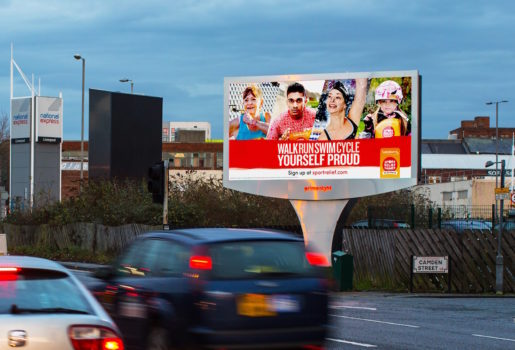Making Space for Digital in the Out-of-Home Industry
by Lindsay Rowntree on 2nd Feb 2016 in News

How can the out-of-home industry, with its roots planted firmly in the physical world, continue to exist and evolve in a digital culture? Mungo Knott (pictured below), marketing and insight director, Primesight, writes exclusively for ExchangeWire about how this one-to-many communication platform is getting a well-deserved upgrade.
The out-of-home industry is firmly rooted in the analogue real world. A physical advertising medium which has been the backdrop to our changing commerce and culture as a nation, bringing brands and consumers successfully together throughout the whole of the last century. As we enter 2016, it is now getting a significant upgrade.
The complexity of the transaction process was for many years processed and certified through the exchange via Royal Mail of handwritten or typed carbon-copied orders distributed to media owners, poster dispatch and bill posting companies, as well as finance and operations departments.
Around the early ‘90s, this first era of transaction was replaced in the second era by the ubiquitous Excel and email. Pen and typewriter were left to one side and companies embraced a faster transaction process, which also contributed to the transition of out-of-home campaigns moving from a one-month to 14-day cycle.
25 years later and we are now entering the third era of transaction as the OOH industry considers the technology of demand- and supply-side platforms linked by API connections. Once again, this is also contributing to the transition of campaign display periods, by offering vastly increased flexibility in transmission as digital screens become a mainstream platform.
In a fundamental shift, this third era moves the participant companies from acting predominantly in isolation, and towards a connected interdependence. It makes this upgrade much more than just the adoption of new technology; because there is a requirement for two key changes within the business process.
Firstly, there is a need for a much greater level of co-operation between participants within the industry.
In order to develop the umbilical cords through which the transaction process will flow, it is necessary to standardise and control the categorisation of out-of-home media assets as well as the coding structures that carry the data.
To this end, the UK OOH Standards committee, which is represented by both major buyers and sellers within the market, has created SPACE. This is a core inventory database which categorises and stores every piece of UK OOH inventory. It creates a control standard to ensure that the one million-plus assets are all uniquely identified within a defined structure, with the result that they can be processed by machine more effectively than by hand.
Secondly there is the challenge of codifying the valuation, negotiation and completion process. This is a significant issue for a medium which has a huge range of variables to which value is traditionally attributed. Whilst audience scores from the industry measurement programme 'Route' are a key element of valuation; there are many other physical and associated data sets that also contribute to the final determination of price. This creates a nebulous approach to inventory selection, negotiation, optioning, and booking; which is challenging to encapsulate in a more automated transaction process.
Looking forward beyond the challenge, the opportunity that is afforded by the third era of transaction is enticing. It can bring together a faster and more efficient trading process with the ability to harness increasingly complex data sets to inform frame selection across OOH print and OOH digital inventory. Initially access will be enabled through purpose-built OOH DSPs, which are currently being developed by technology companies and market buyers.
At the same time, this era can also accelerate wider access to the rapidly growing digital out-of-home market. Already established digital DSPs and ad exchange markets will allow media owners to offer an increasingly flexible approach to accessing their inventory.
 It should be noted, however, that the OOH market is a one-to-many communication platform and the audience data, whilst sophisticated, is a long way from being real-time. For this reason, the third era of transaction will stop at automation. There is currently no scalable mechanic for offering the equivalent of instant access through a momentarily served content page on a personal device. The OOH audience is qualified and predicted at a frame level creating a pre-defined deliverable. This means that much of the established mechanism around digital programmatic purchase will remain invalid within the OOH market for some years to come.
It should be noted, however, that the OOH market is a one-to-many communication platform and the audience data, whilst sophisticated, is a long way from being real-time. For this reason, the third era of transaction will stop at automation. There is currently no scalable mechanic for offering the equivalent of instant access through a momentarily served content page on a personal device. The OOH audience is qualified and predicted at a frame level creating a pre-defined deliverable. This means that much of the established mechanism around digital programmatic purchase will remain invalid within the OOH market for some years to come.
The introduction of DSPs requires a reciprocal development of SSPs for the media owners. Here the challenges vary depending upon the scale and diversity of the media owner portfolio.
A small media owner, with either a single strand print or digital-only inventory, will have few legacy system issues to contend with and a very focused approach to the market. The success of the third era of transaction, however, is reliant on the ability and desire of the major market makers (The Big Four) in the UK to embrace and integrate these new standards and connections. These companies make this era truly scalable.
The complexity of managing a varied portfolio of tens of thousands of individual inventory frames creates a high dependency on legacy systems and a technical inertia to adopting change. This challenge can be met by bringing together technical partners who combine the skills of OOH inventory management, data exchange and digital ad serving.
Developments of live availability to the local direct advertising market are enabling local businesses to search and secure their selected sites online. The next stage is to conduct trading development trials through an early stage SSP to connect with regular market buyers.
We can recognise that we are the custodians of our medium through an exciting time, creating a new landscape which will reshape our ability to deliver effective outdoor advertising.
As we enter this third era of transaction, we now look forward to increasingly realising the benefits of offering our customers the advantages of an OOH digital handshake.








Follow ExchangeWire